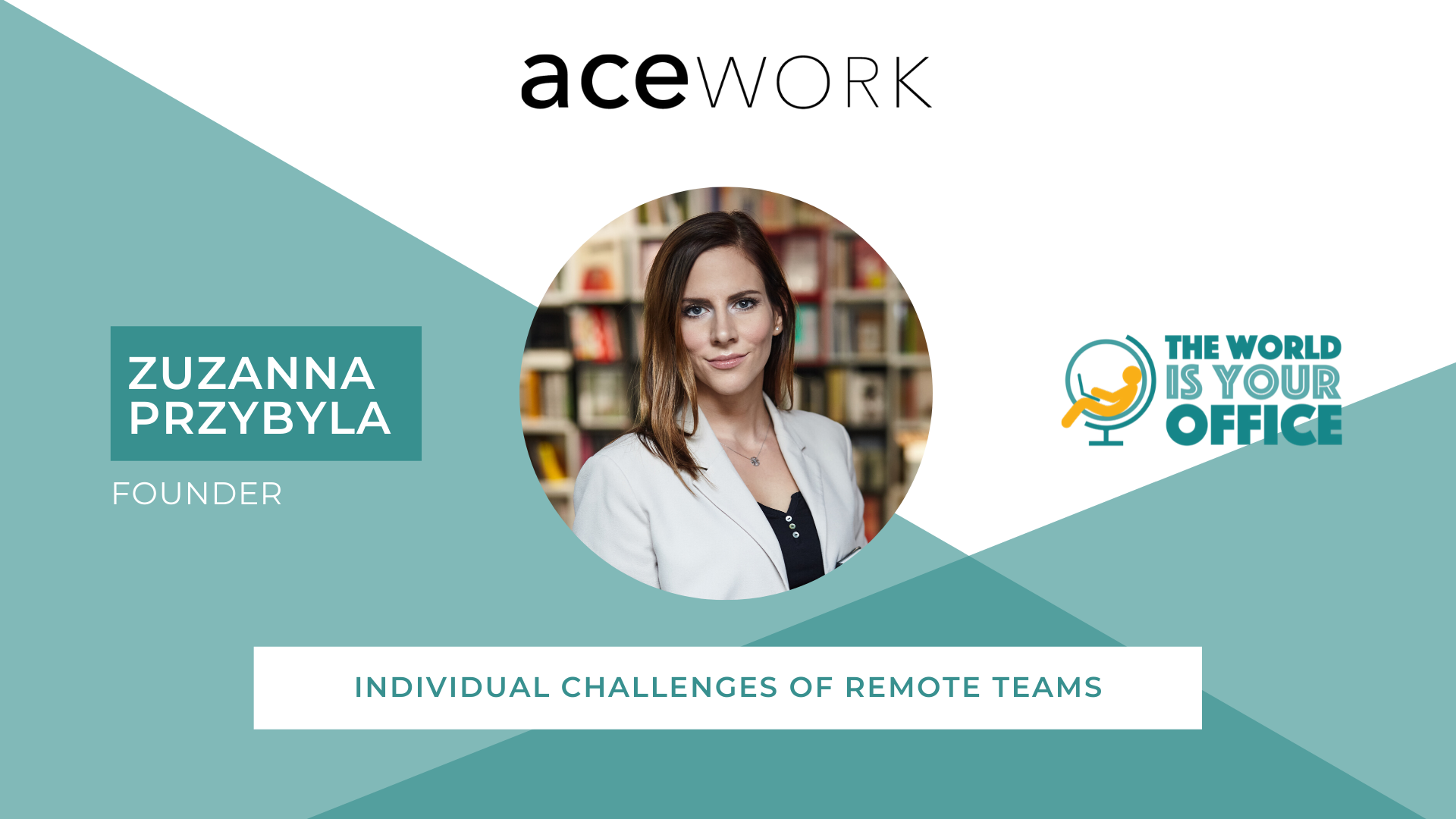Not all remote teams are created equal. Therefore, prescribing general processes, structures or tools can sometimes do even more harm than good when it comes to solving remote team challenges.
Zuzanna Przybyla takes an individual approach to coaching teams at World Is Your Office. After assessing each remote team’s specific challenges, she runs tailored training programs, virtual team building sessions and facilitation workshops. We spoke with Zuzanna about some of the challenges she has seen in various distributed teams, and how she supported each of them to overcome their unique obstacles.
acework: What does success look like for you in a distributed team?
I think that any team should be able to define what “success” means to them, and this is a conversation that any team – regardless of being distributed or not – should have every now and then.
However, there are multiple signs or patterns that I see in successful distributed teams:
1. High levels of trust:
It’s not too easy to build trust among the members (and the manager) in a distributed team; it requires a lot of time and effort. However, when the trust is there, magic happens! A bunch of individuals evolves into an actual team and suddenly it’s so much easier to work towards a common goal. It also helps to stay patient and calm during hard times, and be satisfied with the job. To me, it always seems that trust is the basis and a starting point for everything else.
2. Secure personal relationships
If members of a distributed team like working together and tend to hang out and talk about other topics than just work, it’s a good sign of maturity and success. And again: this also makes work more fun, and increases the chances of achieving business objectives as well.
3. Business results, and more:
Successful distributed teams know what their business objectives are and are capable of delivering them. This brings them satisfaction, fulfillment and growth. Being able to deliver the business objectives allows them also to focus on continuous improvement to make the work easier, results better, learn and develop professionally.
What does it mean to be “remote-first” for you?
To me, ‘remote-first’ means remote is the default way of working. The company might have an office (or multiple offices), yet it’s not obligatory for anyone to work from there. Going to the office should be optional. In remote-first organizations there is a well established culture of asynchronous communication. People have also mastered virtual meetings, and everyone dials in from their chosen workplace. This is clearly different from “office-based-but-with-work-from-home-option” organizations, in which the vast majority of people join meetings in-office, while just a few dial-in remotely and automatically feel excluded.
Why are some of the challenges you come across specific to a particular team?
Just as people are different, so are teams. Each team is unique in it’s own way because of its own, individual culture built by its members. They bring unique personalities, skill sets and experiences to the table. Sure enough, also the type of work and the processes behind them are different between teams. However, there are some common themes around challenges: communication, processes and productivity all usually come up. The underlying reasons for those problems are never the same though. They always need to be addressed individually, with full consideration of a team’s uniqueness.
How do you assess the remote team challenges?
I feel pretty strongly about the fact that a well-designed and executed status quo assessment is key to any project with a distributed team.
In my work, being able to correctly recognize the needs of a certain team or organization is absolutely crucial. Selecting the right tools or methods to address those needs is secondary and depends strongly on how well we identify the initial needs. Because of that, I allocate a significant amount of time and effort to the assessment phase.
The usual process includes:
- – Needs analysis/initial audit according to our framework,
- – Exploratory talks with managers,
- – Exploratory talks with team members,
- – Individually designed questionnaires,
- – Assessment workshops.
As an external facilitator/consultant, how do you create a safe space for participants to share openly about their challenges?
Trust is extremely important when working with a team. Without it, it’s hard to get to the root cause of problems, find out how people feel about them and then build solutions to address them.
My experience shows these are efficient ways to build trust:
- – During any 1:1 conversations between a facilitator/consultant – Flag right away that whatever happens or be said will remain confidential. The same rule applies to diagnostic tools such as surveys. All participants will remain anonymous.
- – During group workshops, a good practice is to start the meeting with a Group Contract. In practice, this means that the group co-creates the rules of the workshop, which everyone declares to follow. Participants tend to raise whatever is important to them. It’s very typical for the people to suggest rules such as “Criticise constructively, and only ideas, not the people”, or “We speak our mind”, or “What happens here, stays in here”. The advantage of a group contract is that it comes from the group and therefore creates a feeling of ownership.
Have you seen any patterns or recurring remote team challenges across the teams you have worked with?
While, as already mentioned, every team is different, what I’ve seen across many distributed teams is that the ones meeting in person every now and then (for example during retreats) are healthier, happier and more efficient. Because of that, one of the most basic recommendations that I tend to give is: meet with your distributed team at least once a year!
There are also patterns when it comes to the challenges. First of all, my experience shows the majority of problems occur in relation to communication. Typical examples would be:
- 1. Lack of clarity concerning the rules and tools for communication
- 2. Information getting lost because of misuse of Slack (or other DM tools)
- 3. Conflicts in the team due to incorrectly recognized emotions/intentions during communication.
Another example of a typical remote team challenge would be loneliness and siloization of team members, who lack daily social interaction with their peers or simply feeling close to their coworkers. However, you can resolve the vast majority of issues if there is will and interest to do so among the team members and managers!






